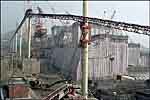Activity 1
Essential Question
- Why do humans modify their environment?
Background
The construction of the colossal Hoover Dam in the 1930s marked the start of the economic and political trend for large dams which still continues today. Big dams are constructed for water supply, flood protection or hydroelectric power generation. The environmental impacts of large dams on river systems are well documented. The most controversial large dam scheme in the world is undoubtedly the Three Gorges Dam on the Yangtze River, China. When completed, this will be the largest man-made structure in the world. It has been constructed not only for the purposes of flood protection, navigation and hydroelectric power generation, but perhaps as a political statement to the world. However, such a large structure inevitably has considerable impacts on the local inhabitants and the environment.Instructional Strategies
 |
Strategy 1 |
Goal Setting
- Use a motivating website such as this one to begin your discussion of dam building:
http://www.geocities.com/bobarnebeck/dams.html. Ask students why beavers build a dam. Do they build dams for the same reasons that people do? - Provide students with the geography standards to be addressed in this module. Discuss the standards in light of what they have just discussed.
- Relate the standards to the goals of this module.
- Continue to discuss the standards as students do other activities in the unit.
Check for Understanding
- Have students orally review the standards for this unit. Have them explain them in their own words.
 |
Strategy 2 |
Accessing Prior Knowledge
- Explain to students that in order to engage in problem solving or analyzing issues, they need to gather new information and link it to what they already know. This process is referred to as "constructing meaning."
- Explain that prior information helps them bring meaning to new information.
Ask students to reflect on the following key questions:
- What do you already know about why people build dams?
- What issues do we need to explore in the Three Gorges Dam?
- Use a KWHL Chart to help students access prior knowledge and construct meaning from the new information they will be learning.
- Have students work in pairs or form groups of three. Each group is to generate as many descriptive words as they can that might describe what they know about the Know and the Want of why people build dams. Give the group time to generate these descriptors, and then ask a member of each group to share the list of qualities that their group associated with dams.
- Once students have shared their descriptors, have them generate several summary statements that they think generally describe why people build dams (e.g., "To control flooding" "To generate power" "To improve navigation and decrease transportation costs" "To provide water resources").
Why Do People Build Dams?
|
What We Know
about Dams |
What We Want to Find Out
about Dams |
What We Learned
|
How Can We Learn More
|
|
|
|||
|
Categories of Information we expect to use: A. B. C. D.
|
|||
Check for Understanding
- Ask students to predict what impact they think dams have had on the environment and people historically. You may want to post these statements and predictions. As the students continue in the unit, periodically come back to them and have students see if their original ideas still hold up. At the conclusion of the unit, ask the students the L and the H.
 |
Strategy 3 |
Note-taking and Reciprocal Learning
- Distribute "Resource Packet" Information on:
- Have students work in cooperative groups to become "expert" on one section of the resource packet. Have them share their expertise with other groups. Summarize the information in a full-class discussion.
- Have students take notes during the discussion and add the information to their notebooks as the teacher records it on a transparency.
- Use the Case Analysis Worksheet to use their knowledge to think about issues related to the dams and to make connections to potential problems.
Check for Understanding
- Have groups share their information with the total class, encouraging students to add additional information to their Case Analysis Worksheet.

 Module Menu
Module Menu Printable View
Printable View
